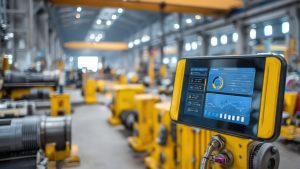Mountains of maintenance logs, work orders, and sensor readings can overwhelm any maintenance team. But what if those documents could talk? That’s the power of Natural Language Processing (NLP), a branch of artificial intelligence focused on enabling computers to understand and use human language. Natural Language Processing (NLP) is changing how we interact with machines and access information, impacting industries from healthcare to finance.
Table of Contents:
The Role of Natural Language Processing in Maintenance Management

NLP helps maintenance teams work smarter by unlocking data trapped in text, making it easily accessible, and improving decision-making. The growing use of NLP in maintenance is driven by the sheer volume of available text data, including vast amounts of maintenance logs and customer reviews. This is similar to how NLP and machine learning are transforming medicine.
Understanding Natural Language Processing (NLP)
NLP teaches computers to read, understand, and answer questions. It’s like having a digital assistant that can interpret and summarize large datasets of text.
NLP analyzes text, including sentiment analysis, which identifies the emotional tone (positive, negative, or neutral) of language.
How NLP Works
NLP uses many processes to analyze human language.
- Preprocessing: Cleaning and preparing the data, like removing unnecessary information and standardizing formats.
- Tokenization/Parsing: Breaking down text into individual units (tokens) and identifying parts of speech, similar to analyzing a sentence.
- Embeddings: Converting words into numerical representations for computers to process mathematically, enabling sentiment analysis and other NLP tasks.
- Named entity recognition: Identifying key information like product names or locations within a text. Early machine translation leveraged these theories.
- Modeling: Choosing and training suitable AI models for specific tasks, like text classification or language translation. Modeling approaches include seq2seq, transformer models (for sequential data like natural language text), and autoregressive models (predicting the next token in a sequence).
Enhancing Data Accessibility with Natural Language Processing (NLP)

NLP can pinpoint relevant information within vast amounts of text. This data analysis makes it easy for maintenance technicians to find crucial data quickly.
Semantic search, considering the meaning behind words rather than just keywords, is vital for accuracy and improved search results. This goes beyond simple keyword matching to offer deeper language understanding and improved document retrieval.
Improving Decision-Making
NLP transforms maintenance data into actionable insights, facilitating smarter decisions. With NLP, the history of machine maintenance data provides predictive capabilities, identifying and preventing problems before they occur.
Streamlining Communication
NLP improves communication and collaboration among maintenance personnel, regardless of language barriers. NLP facilitates multilingual systems and voice control, freeing up technicians’ hands.
NLP empowers voice interaction with computers. The National Library of Medicine (NNLM) advances the use of NLP in medical libraries. It is headquartered in Bethesda with several offices that provide training resources.
Automating Routine Tasks
NLP automates routine tasks such as data entry, reporting, and work order creation. This frees up time for more important tasks and increases efficiency.
This shift reduces tedious paperwork and offers substantial efficiency gains. The financial industry, with its high volume of unstructured documents, benefits from this automation. NLP tools also assist with customer support and identify patterns in unstructured text.
Real-World Applications of Natural Language Processing (NLP)
Case Study 1
A manufacturing plant integrated NLP into its systems to consolidate data from various sources like emails and handwritten notes. The platform linked with all of their systems.
Technicians could access needed data instantly via voice search, improving diagnostics and preventing downtime. This reduced stress by enabling quick issue identification.
Case Study 2
An energy company used NLP to predict pipeline maintenance issues. The software analyzed decades of maintenance logs along with CRM data.
This predictive maintenance approach safeguards both revenue and the environment. Advanced language models can process vast amounts of historical data to inform decision-making, similar to systems like RAVN.
Challenges and Considerations
Implementing NLP requires careful planning, including ethical considerations about data access. Understanding the limitations of NLP is crucial for responsible use.
High-quality data is essential for accurate results. Integrating older systems with NLP software may present challenges related to data structures and compatibility with advanced language models.
Conclusion
Natural Language Processing (NLP) empowers maintenance teams by enabling fast, reliable analysis of large amounts of data. From predictive maintenance to streamlined communication, NLP is transforming how businesses operate. By leveraging advanced techniques and tools, NLP helps companies solve complex problems with data analysis platforms like SAS, which utilizes NLP for various tasks, including marketing and risk assessment.
The integration of NLP with programming languages and deep learning algorithms has significantly enhanced its capabilities, allowing for more sophisticated data analysis and improved decision-making processes. This synergy has enabled businesses to develop more accurate predictive maintenance models, reducing downtime and maintenance costs. NLP’s ability to process and understand natural language also facilitates better communication within maintenance teams, improving collaboration and efficiency.
In addition to predictive maintenance, NLP is crucial for refining user queries in search engines, enhancing the accuracy and relevance of search results. This capability not only improves the user experience but also aids businesses in understanding customer needs and preferences. By analyzing customer queries and feedback, companies can tailor their services and products to better meet market demands.
Addressing implementation challenges is vital to fully realize NLP’s potential. Ensuring data quality, overcoming integration issues, and training personnel to use NLP tools effectively are essential steps for a successful implementation. Moreover, it is crucial to utilize NLP responsibly, considering ethical implications such as data privacy and security. Responsible use of NLP ensures that the technology benefits the industrial sector without compromising ethical standards.
NLP tools and resources, combined with thoughtful application, promise to revolutionize industries further. From refining user queries and improving customer experience to accelerating business processes, NLP’s impact is far-reaching. By harnessing the power of NLP, businesses can gain valuable insights, streamline operations, and enhance overall productivity. As NLP technology continues to evolve, its applications will expand, offering even more opportunities for innovation and growth in various sectors.



